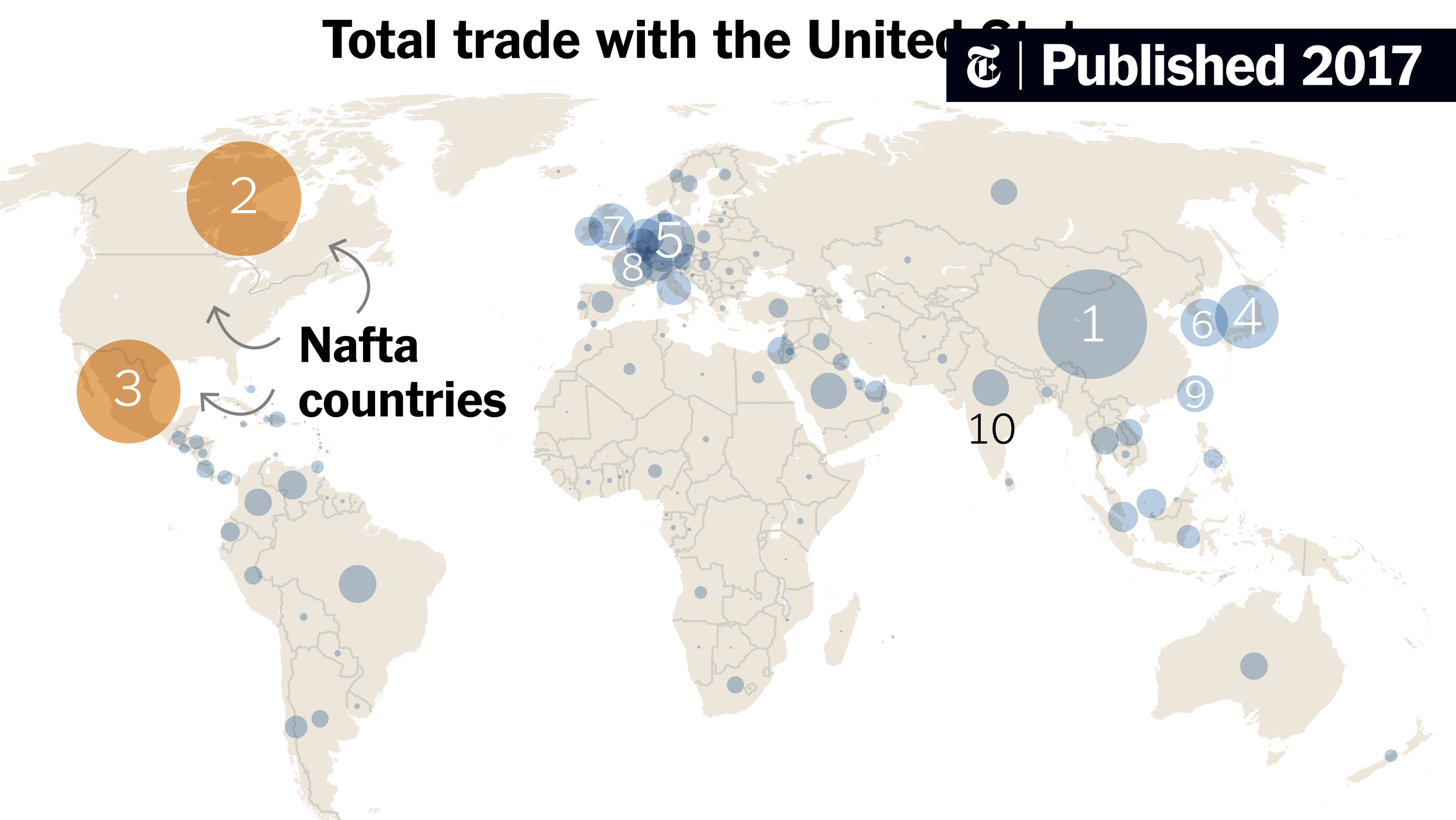How Canada And Mexico Can Boost Trade Despite US Tariffs

Table of Contents
Diversifying Trade Relationships Beyond the US Market
The over-reliance on the US market has historically been a vulnerability for both Canada and Mexico. Diversifying trade relationships is crucial to mitigating the impact of future protectionist policies.
Exploring New Trade Partnerships
To reduce reliance on a single major trading partner, both nations should actively pursue new trade agreements and opportunities globally.
- Seek new trade agreements with Asian countries (e.g., CPTPP): The Comprehensive and Progressive Agreement for Trans-Pacific Partnership (CPTPP) offers access to a vast and growing Asian market, reducing dependence on North American trade flows.
- Explore Latin American markets: Strengthening ties with other Latin American nations through regional trade agreements can create new export and import channels, bolstering economic resilience.
- Strengthen ties with the EU: The European Union represents a significant market with high purchasing power, offering opportunities for both Canadian and Mexican businesses to expand their reach.
Diversification reduces the risk associated with US trade policies. The success of the CPTPP for its members serves as a compelling example, demonstrating the benefits of expanded market access and economic diversification.
Fostering Intra-Regional Trade
Increased collaboration within North America, beyond the US, can significantly enhance Canada-Mexico trade.
- Increase collaboration on infrastructure projects (e.g., improved cross-border transportation): Investing in modern and efficient transportation networks, including improved roads, railways, and border crossings, will reduce transit times and costs, making cross-border trade more efficient.
- Development of regional value chains: Creating integrated supply chains between Canada and Mexico promotes greater economic integration and reduces vulnerability to external shocks.
- Support for small and medium-sized enterprises (SMEs) involved in cross-border trade: Providing SMEs with resources and support to navigate the complexities of international trade will unlock their potential to contribute to increased bilateral commerce.
Streamlined customs procedures and reduced transportation costs directly translate into substantial economic gains. For example, reducing border wait times by even 30 minutes could save businesses millions of dollars annually in fuel and labor costs, directly boosting Canada-Mexico trade.
Strengthening Bilateral Trade Agreements and Cooperation
The Canada-Mexico-United States Agreement (CUSMA), while a significant achievement, can be further strengthened to maximize its benefits for both Canada and Mexico in the face of US trade policies.
Enhancing the Canada-Mexico Agreement (CUSMA)
CUSMA provides a strong foundation for bilateral trade, but proactive enhancements can further solidify the relationship.
- Identify areas for improvement in CUSMA: Regular reviews and updates to the agreement are essential to address evolving trade dynamics and ensure its continued relevance.
- Focus on dispute resolution mechanisms: Robust and efficient dispute resolution mechanisms are crucial for resolving trade disagreements quickly and effectively, minimizing disruptions to Canada-Mexico trade.
- Explore opportunities for increased trade in specific sectors (e.g., technology, renewable energy): Identifying and fostering growth in specific high-value sectors can drive economic expansion and enhance bilateral trade relationships.
CUSMA's strong provisions on dispute settlement offer a mechanism to address unfair trade practices. Leveraging these clauses effectively is crucial to safeguarding Canada-Mexico trade interests.
Improving Regulatory Harmonization
Reducing regulatory barriers is key to boosting bilateral trade.
- Streamline customs procedures: Harmonizing customs procedures and regulations between Canada and Mexico will facilitate smoother and faster cross-border movement of goods.
- Standardize product regulations: Alignment of product standards and regulations will reduce compliance costs for businesses and enhance market access.
- Enhance cooperation on sanitary and phytosanitary measures: Harmonizing food safety and plant health regulations will facilitate trade in agricultural and food products.
Regulatory alignment reduces trade friction and lowers costs, resulting in increased competitiveness and enhanced Canada-Mexico trade volumes.
Investing in Infrastructure and Technology
Modern infrastructure and technological advancements are crucial for efficient and cost-effective cross-border trade.
Modernizing Border Infrastructure
Investing in improved border infrastructure is vital for efficient cross-border flows.
- Invest in improved border crossings: Expanding capacity and modernizing existing border crossings will reduce wait times and improve the flow of goods and services.
- Enhance digital customs processes: Implementing digital customs systems will streamline processes, reduce paperwork, and improve transparency.
- Improve transportation networks (roads, railways): Upgrading transportation infrastructure is crucial for efficient and cost-effective movement of goods between Canada and Mexico.
Reduced border wait times translate directly into significant cost savings for businesses, boosting Canada-Mexico trade competitiveness.
Leveraging Digital Technologies
Digital technologies can transform cross-border trade.
- Promote the use of e-commerce platforms for cross-border trade: Facilitating e-commerce will open up new markets and opportunities for businesses of all sizes.
- Develop secure digital trade systems: Secure digital systems enhance transparency and efficiency, making cross-border trade easier and safer.
- Invest in digital literacy training for businesses: Equipping businesses with the skills to utilize digital tools effectively is crucial for maximizing the benefits of digital trade.
Digital technologies can overcome geographical barriers, improving efficiency and reducing costs for all participants in Canada-Mexico trade.
Conclusion
The challenges posed by US tariffs necessitate a proactive and strategic approach from Canada and Mexico to bolster their bilateral trade relationship. By diversifying trade partnerships, strengthening existing agreements, and investing in infrastructure and technology, both nations can significantly mitigate the impact of these external pressures. Focusing on enhanced Canada-Mexico trade will not only foster economic growth but also strengthen their regional influence. The opportunities for increased Canada-Mexico trade are substantial, requiring a commitment to collaborative strategies and innovative solutions. Let's work together to strengthen Canada-Mexico trade and build a more resilient and prosperous future.

Featured Posts
-
 How To Stream 1923 Season 2 Episode 4 For Free Tonight
May 27, 2025
How To Stream 1923 Season 2 Episode 4 For Free Tonight
May 27, 2025 -
 Kanye West Faces Legal Action From Taylor Swift Over Explicit Allegations
May 27, 2025
Kanye West Faces Legal Action From Taylor Swift Over Explicit Allegations
May 27, 2025 -
 Watch 1923 Season 2 Episode 5 Online Tonight Free Streaming Guide
May 27, 2025
Watch 1923 Season 2 Episode 5 Online Tonight Free Streaming Guide
May 27, 2025 -
 Nora Fatehi The Queen Of Floral Saree Style
May 27, 2025
Nora Fatehi The Queen Of Floral Saree Style
May 27, 2025 -
 Podcast Navigating Low Inflation A Guide
May 27, 2025
Podcast Navigating Low Inflation A Guide
May 27, 2025
Latest Posts
-
 Bts Reunion New Teaser Fuels Comeback Anticipation
May 30, 2025
Bts Reunion New Teaser Fuels Comeback Anticipation
May 30, 2025 -
 Bts Reunion Teaser Comeback Speculation Ignites Army
May 30, 2025
Bts Reunion Teaser Comeback Speculation Ignites Army
May 30, 2025 -
 Viral Photos Btss V And Jungkook Display Military Trained Bodies Ahead Of Discharge
May 30, 2025
Viral Photos Btss V And Jungkook Display Military Trained Bodies Ahead Of Discharge
May 30, 2025 -
 Rise In Texas Measles Cases New Infections Not Part Of Main Outbreak
May 30, 2025
Rise In Texas Measles Cases New Infections Not Part Of Main Outbreak
May 30, 2025 -
 Bts Members V And Jungkook Show Off Impressive Post Military Fitness In New Photos
May 30, 2025
Bts Members V And Jungkook Show Off Impressive Post Military Fitness In New Photos
May 30, 2025
